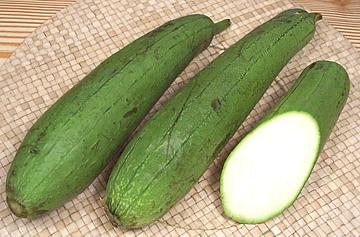All these gourds are of family Cucurbitaceae, thus close relatives of the Cucumbers, Squash, Melons, but their cooking properties are different from all the rest of the family except some other goards, like the Bottle Gourd.
 [Chinese Okra, Vine Okra, California Okra; Patola (Philippine); Muop Khia
(Viet); Buap Liyam (Thai); Turai, Torai, Dodka, Jhinga (India); Sigua,
Sing Qua (China); Oyong (Indonesia); Luffa acutangula]
[Chinese Okra, Vine Okra, California Okra; Patola (Philippine); Muop Khia
(Viet); Buap Liyam (Thai); Turai, Torai, Dodka, Jhinga (India); Sigua,
Sing Qua (China); Oyong (Indonesia); Luffa acutangula]
Grown all over Southeast Asia, these have also long been a common vegetable here in Southern California. They are used by Asians of all stripes, from India to the Philippines. Often sold as "Chinese Okra", it is entirely unrelated to Okra and does not resemble it in flavor, texture, cooking properties or size, only in that it has ridges.
The skin is stiff and thin with sharp ridges running the full length. The flesh is very delicate in both flavor and texture, yet holds its shape well when cooked. The photo specimen was 19 inches long, 2-1/2 inches diameter and weighed 14 ounces. They vary in shape and size. The cut one was more uniform in diameter, 21 inches long and weighed just over 1 pound.
More on Gourds.
 [Egyptian Luffa, Silk Gourd, Vietnamese Lufa; Patola (Philippine);
Muop Huong, Totura Muop (Vietnam); Galka, Gilki, Ghosavala (India);
Sigua, Sing Qua (China); Oyong (Indonesia); Luffa cylindrica
alt L. aegyptiaca]
[Egyptian Luffa, Silk Gourd, Vietnamese Lufa; Patola (Philippine);
Muop Huong, Totura Muop (Vietnam); Galka, Gilki, Ghosavala (India);
Sigua, Sing Qua (China); Oyong (Indonesia); Luffa cylindrica
alt L. aegyptiaca]
Probably of African origin, these are an eating variety which may be cylindrical or snake shaped with little or no ridging. Cylindrical ones are generally eaten when they are about 8 to 10 inches long, snake shaped ones depending on variety. The photo specimen in the center was 11 inches long and 2-1/2 inches diameter.
These gourds have not yet become common in Southern California markets, but I have found them in Indian markets in Artesia and some Asian markets in San Gabriel. They have a more distinctly vegetable flavor than the Angled Luffa and store considerably longer. In California they are grown commercially, mostly for the bath sponge produced when they mature and dry out. They are also grown in Florida where some may be used for cooking.
More on Gourds.
 [Sweet Cee Gua; Taiwan squash; Luffa cylindrica alt L. aegyptiaca]
[Sweet Cee Gua; Taiwan squash; Luffa cylindrica alt L. aegyptiaca]
In Taiwan, a number of luffa varieties have been developed that are short and blocky. The photo specimens are the most extreme - most Taiwan varieties are narrower (2-1/2 to 3 inches diameter) and at least twice as long as wide. These specimens were 5 inches long, 4-1/4 inches diameter and weighed 1 pound each. My most recent purchase was from a large Asian market in Los Angeles (Alhambra) for 2018 US $1.29 / pound, labeled as "Sweet Cee Gua". They seem to be most available in October-November.
More on Gourds.
Slice or cube per the recipe (the seeds are edible). Cook gently. Unlike squash, they hold their shape well with cooking and do not become mushy.